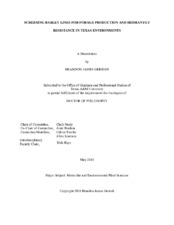| dc.description.abstract | Barley (Hordeum vulgare) has been largely absent from Texas’s cropping systems with no current public or private breeding program in the state since 2001. However, barley may become increasingly important due to a rapidly growing dairy industry, especially in the Texas Panhandle. For these dairies, barley may provide a more drought tolerant alternative as a cool season silage source compared to other small grains. This would be highly beneficial to the High Plains region due to the depletion of the Ogallala aquifer. Additionally, roughly 1.2 million hectares of small grains are grazed in Texas and barley may offer an alternative source of fall forage for beef cattle. Moreover, barley provides a less desirable host to insects such as Hessian fly (Mayetiola destructor), which can be devastating to wheat (Triticum aestivum). The Hessian fly is a major pest of small grains and can cause significant economic losses in some areas of Texas. Small grains intended for grazing are typically planted much earlier in the fall and hence are more vulnerable to Hessian fly damage. Consequently, finding resistant lines is of great importance. Therefore, the objectives of this study were to 1) Identify experimental barley lines with superior forage and silage production in Texas, 2) Screen barley lines for Hessian fly resistance, and 3) Conduct stability, repeatability, and heritability analysis on winter barley lines.
Lines examined in this study were previously screened and selected from 298 winter and facultative lines obtained from the Triticeae Coordinated Agricultural Project (TCAP) for adaptation to Texas environments based on disease resistance, vernalization requirements, and frost tolerance. All silage and Hessian fly field trials were laid out in an alpha lattice design with two replications. Forage and silage trials were conducted in College Station, McGregor, and Dimmitt, Texas, during the 2016 season and McGregor, Comanche, Brady, and Dimmitt in 2017. Hessian fly trials were located in McGregor in 2016 and McGregor and Brady in 2017.
Normalized difference vegetative index (NDVI) and plot height measurements in the fall indicated significant differences (P<0.0005) among barley lines at all environments except for NDVI in two out of six site years. Spring silage dry matter yields revealed significant differences (P<0.05) among barley lines in three out of four site-years. Several of the top yielding barley lines exceeded 15 tonnes per hectare in Comanche, Texas, which was the best producing environment for spring silage. The top producing barley line out-yielded the top commercial barley or wheat check by an average of 1.25 tonnes/hectare across the four locations. Large variation of Hessian fly field trial infestations prevented good separation between resistant and susceptible lines. In a subsequent growth chamber trial, 13% (18 of 140) of the barley lines showed potential resistance. Overall, only 6% (9 of 140) were rated as resistant across all field and growth chamber trials and only one line was found to have no flies in any trial. Biplot analysis revealed which lines were the most and least stable for fall forage and spring silage production across environments. Height in both forage and silage trials was found to be repeatable and heritable while NDVI was determined to be neither repeatable nor heritable. | en |


